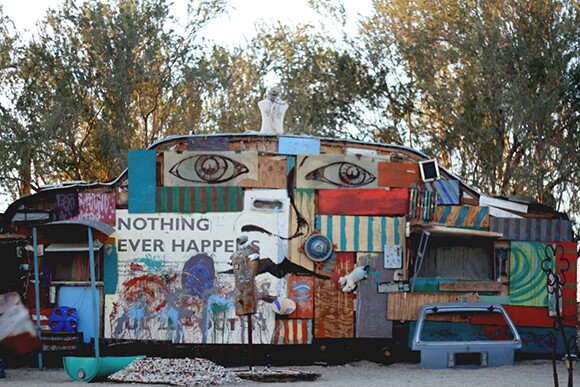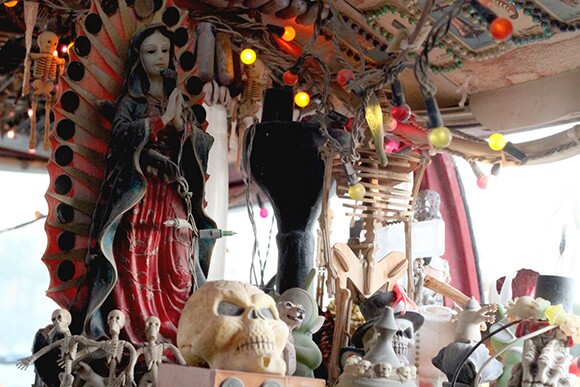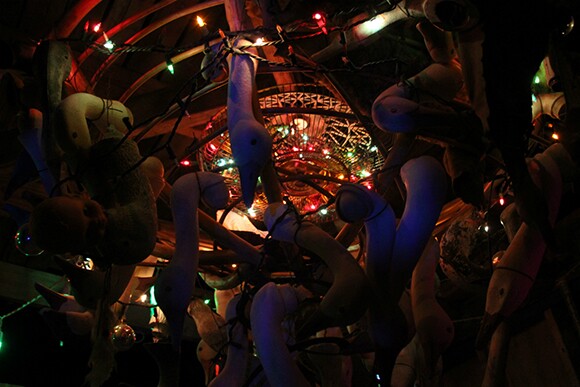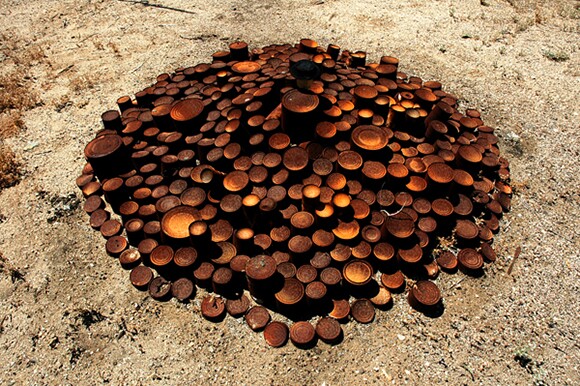Off the Grid Enlightenment and Spirit at East Jesus
East Jesus is a habitable, experimental art project that champions a communitarian, collective culture in the heart of Imperial County's Slab City. The brainchild of Charlie Russell, a Slab City inhabitant who had come to work alongside Leonard Knight at his folk art landmark Salvation Mountain, East Jesus began in 2007 while Russell's sculptures and art cars encouraged the design of this new complex in the center of the eclectic Slab City community. Slab City, sometimes known as "The Last Free Place in America," is a campsite without electricity or running water or landlords to pay rent to that welcomes dissenters, adventurers, and artists with open arms and trust to live and work dexterously. It is in these environs that Charlie Russell created East Jesus, the idealism and conditions for the evolution of this ever-changing process in installation work present for the expansion of Russell's vision and expression within the community. East Jesus currently houses twelve residents, where prospective inhabitants have to build their own homes in a culture where occupants have to demonstrate that they can bring something into the place instead of just taking from it.


Frank Redford, a former restaurateur and chef, usually handles the guided tours of the East Jesus installations. Redford met Charlie Russell as he used to repurpose the garbage people used to come out and dump into the Slab City community in order to avoid paying a disposal fee, prompting Russell to use these materials for his art cars and sculpture work. "We have a motto: 'Recycle it, reuse it, repurpose it or set it on fire.' You have to do something with this garbage, you can't keep burying it. We call it art, nobody argues with us out here, so we get away with it," states Redford. "Cinnabar Charm" is East Jesus's pioneering work of art, Charlie Russell's art car that used to transport him to Burning Man before his unfortunate passing in 2011, inspired by the poem of the same name by Thom Metzger. The VW Westfalia campmobile is chock-full of detail, ingenuity and wit, unearthing elements and secrets upon every return visit, powered by a photovoltaic panel mounted to the pop-top roof. "Charlie was a mad genius. He passed away at 46 years of age and had attended university in Germany, he was a sound engineer, definitely a Renaissance Man. He bought a piano, taught himself how to tune it, then taught himself how to play it," affirms Redford. Frank Redford's "Bottle Wall" is a continuation of Charlie Russell's work, who had collected about 1500 bottles, a masterful East Jesus structure where repurposed bottles let the sun shine through in the daytime and light up at night. "The universe wanted me to be here and I wanted to leave a mark on the world after being dealt a death sentence. I was in remission from cancer and going through a cancer treatment, so I needed to leave something behind," states Redford referring to the art piece.



The works of art at East Jesus possess a haunting quality, peering into a foreseeable future and returning to the past by turning garbage into art, some materials scavenged for, others dropped off by East Jesus enthusiasts for consideration. "Fame Retardant" is an art piece by artists Ben Wolf and Heidi Tullmann, a sunken house made out of collected materials, an allusion to the months the artists spent in Detroit and New Orleans. Ben Wolf also created "Fainted Foundation" at East Jesus, a collapsing house made from materials gathered from an abandoned apartment complex in Inglewood, based off Duchamp's "Nude Descending a Staircase, No. 2." "The Dusty Junk" is a vehicle inspired by a Chinese junk boat that the East Jesus locals use for trips around Slab City, particularly to its hot springs. "Tower of Barbarella" by Royce Carlson, is, as many East Jesus pieces are, an evolving structural work of art, where the artist begins with an idea and/or structure and other people continue to add to it, feeding a desire to build things that other artists can add to. "We believe in change, everything has to change. That's one of our big things. People come out and do some art over other art, or add to it or subtract from it, so the place is constantly growing," states Redford. Another work in progress by Royce Carlson is "Albrino," a brine shrimp sculpture comprised of discarded plastic bags, inspired by the East Jesus myth that there exists a giant mutant whale albino shrimp lurking in the depths of the Salton Sea. "You throw out all these plastic bags, they come back to bite you in the ass," Redford indicates. The TV wall entitled "The Television Will Not Be Revolutionized" by artist Flip Cassidy is a stirring social commentary on media influence over people's lives. "Walter," a buried bus by hybrid arts and sciences organization "Transit Antenna" was a New York city transit bus turned into a biodiesel RV where permanent bus driver "Earl" currently presides over the festivities. There's also "The Can Organ" by Ty Johnson, where dripping rain or sand causes it to emit sound, amongst many other art pieces to admire at the East Jesus art garden. "We don't believe in artistic failure. If you don't like something you created, we'll help you set it on fire," affirms Frank Redford.

The East Jesus community is guided by a proactive, sustainable way of life, where East Jesus residents grow their own food, recycle the water they bring in on two 250 gallon bladders through a pump and pipes via their gray water flowing into the plants, and also by reusing their waste or "humanure" as fertilizer. Everything runs on solar power panels, which bring power to the battery bank that Charlie Russell designed. "It's a lot easier to teach about the idea of recycling and conservation when you're out here, where there are no other options, where if you want electricity or fire, you have to generate it yourself," affirms Redford. "Sustainability is like a drug addiction where you go, 'Oh, wow! I am generating free power from the sun, now I got a little bit of power and I can only do a little bit of things. If I could get a little more power, then I can do more things. What if I had more power?' It's that little taste of being able to generate your own mobility and freedom, you're not forced to plug in where they tell you to plug in."
Visitors to East Jesus are encouraged to abide by the East Jesus Survival Guide, a comprehensive, straightforward set of rules culled from years of experience in communal living. "Another one of our mottos is: 'Nothing ever happens, until it happens.' People talk about their great plans, but they never get anything done. We get away from that, nothing's going to happen until you get up and make it happen," states Redford." "First 48 hours is free, if you want to stay longer than that, we expect at least one hour of work from you a day," he explains.


East Jesus also houses several other assets for its community members, such as a music room with a grand piano, an art supplies tent, a library, a living room and bar area, as well as future projects such as backyard aquaponics and an adobe preparation/mud-wrestling pit. "We do have a library because there's no need to be uneducated out here in the desert, plus Wi-Fi so you can Facebook about your whole experience. We do have a stripper pole because strippers will not show up if you don't have a pole. Charlie's ashes are in the music room, his mother decided that he wasn't happy in Maine, so she brought him out here to keep an eye on us. Other people have left their loved ones' ashes here as well," declares Redford. The East Jesus design lends itself to generate memorable moments, such as the placing of the shower area and piano together, so you can listen to live music as you bathe in the desert. "So basically when you were a kid, you were building that clubhouse in the backyard. This is what it would become if you would have kept working on it," asserts Frank Redford.


East Jesus currently raises funds through donations and fees related to camping there, their website's Chasterus Foundation, and the sale of T-shirts. "Any system eventually decays to chaos, we just figured if we started out our system with chaos, shouldn't be a problem. People here are in charge of their own departments and it works on a small scale, but if it gets too big you have cliques and groups and stuff. The idea is to make it feel like home so people come here and they want this to continue," indicates Redford. "The term East Jesus is not a religious connotation, it's an American idiotism meaning all the way out past the end of services. So 'I live out past East Jesus' used to mean you live out past where the postal service or the telephone lines go. A lot of our friends, they just want to get out of the city and just take a look at things from a different perspective, there's not a lot of billboards here or the usual crap," explains Redford.
East Jesus residents are also encouraged to go back out into "the real world" for an extended period of time at least once per year, the homes that they built for themselves at East Jesus awaiting them upon their return. "The real world is that cell mentality. You don't mingle with your neighbors, you go to your job, you work in your cubicle, you get back in your car, you drive back and don't engage what's going on around you," declares Redford. Placing a high value on the personal journey and the cultural pilgrimage while gambling on creativity and resourcefulness, as well as communal living and ethos, East Jesus welcomes visitors to encourage an exploration of different participatory avenues at East Jesus and beyond.
"We believe in hospitality. We always come up with an extra plate of food and we always find a place for somebody to sleep because, yeah, we're just homeless bums living in the desert, we don't mind sharing what we got," Redford exclaims.


To find out how you can visit or donate to East Jesus please visit their website.
Further Reading on Slab City and Salvation Mountain:
Lessons from the Slab: Slab Sand Cloud Grid, New Works by Sam Kronick and Hermione Spriggs
Amy Sanchez investigates the project "Slab Sand Cloud Grid," which brings together a set of objects and interventions produced collaboratively in and about one of Southern California's most notoriously off-the-grid communities: Slab City.
Leonard Knight and Salvation Mountain
People made pilgrimages from all other the globe to view Salvation Mountain, and more importantly, visit with its creator, Leonard Knight, who died this month at 82.
Dig this story? Sign up for our newsletter to get unique arts & culture stories and videos from across Southern California in your inbox. Also, follow Artbound on Facebook, Twitter, and Youtube.




